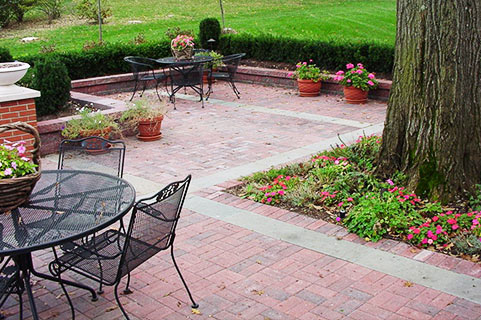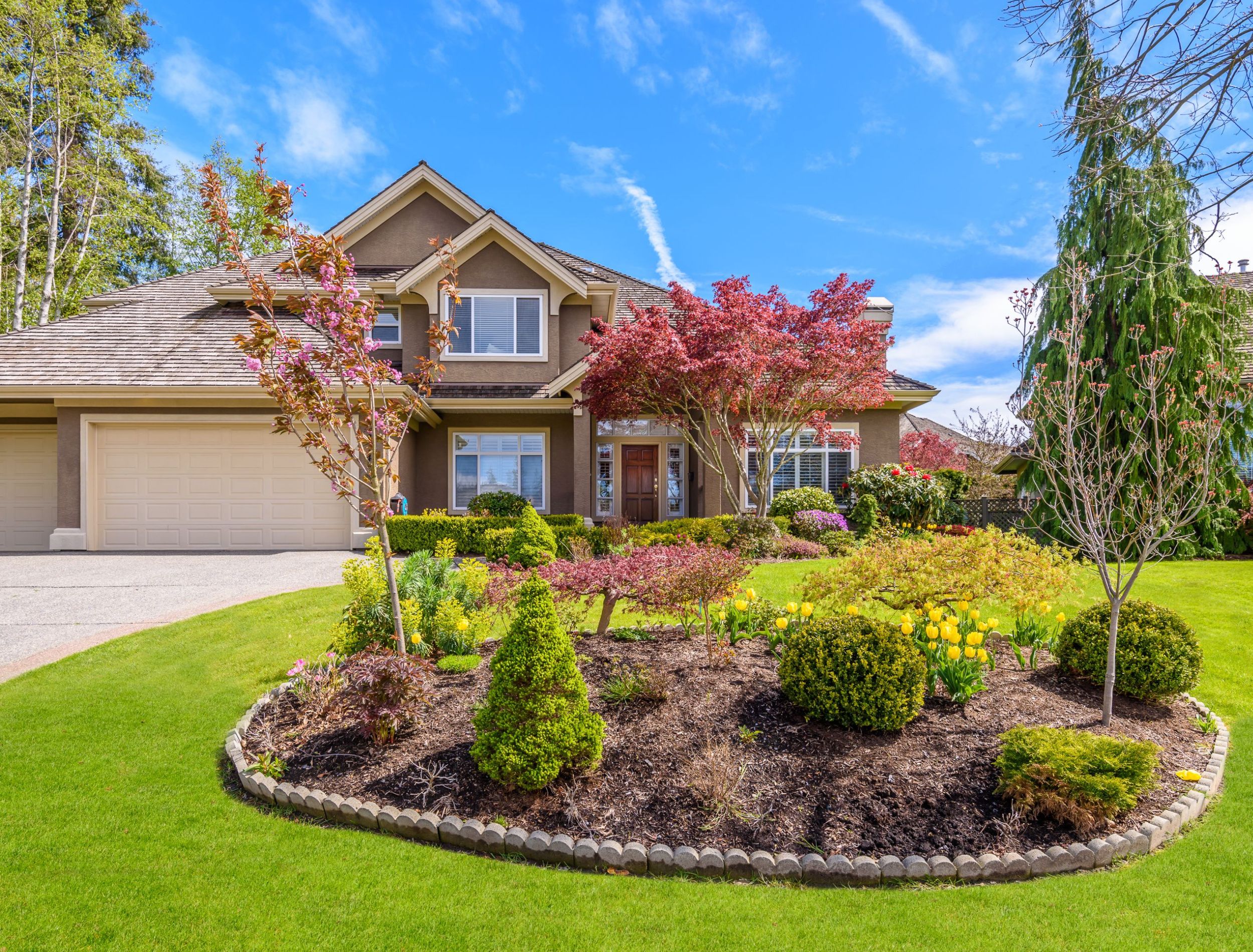Exploring Different Sorts Of Landscaping to Boost Your Outdoor Environment
Landscaping plays a vital role in specifying exterior spaces. Various designs, from typical gardens to modern minimalist styles, supply unique advantages for improving looks and feature. Integrating components like xeriscaping and native plants can add to ecological equilibrium. Recognizing the interaction of hardscape and softscape is vital for developing inviting settings. The choices available can be frustrating, prompting one to assess which design finest straightens with their vision for an outdoor refuge.
Conventional Yard Landscape Design

While several modern-day yards embrace minimalism and native growings, traditional garden landscaping stays a treasured technique that highlights symmetry, structure, and decorative attributes. This design often incorporates formal geometric designs, where pathways, hedges, and flowerbeds are prepared with accuracy. Central centerpieces, such as fountains or sculptures, attract the eye and supply a feeling of harmony.Traditional landscape design frequently includes a selection of plant kinds, showcasing seasonal blossoms and evergreen elements. Classic hedges, perennials, and annuals create vibrant colors and structures throughout the year. Furthermore, pergolas, arches, and trellises include vertical interest and function as assistance for climbing up plants, boosting the total aesthetic.The use all-natural materials, such as rock and timber, more enhances the conventional landscape, contributing to a timeless quality. Inevitably, this style welcomes relaxation and enjoyment, making it a precious option for those looking for an attractive exterior setting.
Modern Minimalist Landscape Design
Modern minimalist landscaping emphasizes simpleness and performance, identified by open areas and clean lines. Secret qualities consist of a limited plant palette and thoughtful hardscape layout that focuses on use and aesthetic charm. Effective plant selection techniques additionally enhance the minimalist method, developing relaxing exterior settings that urge leisure and reflection.
Trick Characteristics of Minimalism
An expanding pattern in landscaping is the embrace of minimalism, defined by simpleness and performance. Minimalist landscape design focuses on tidy lines, open spaces, and a limited color palette, promoting a feeling of harmony. Elements are thoroughly curated to prevent mess, allowing each component to attract attention. Making use of all-natural products, such as stone and wood, boosts the natural feeling while preserving a visual equilibrium. Furthermore, minimal layouts often include geometric shapes, which can produce visual interest without frustrating the senses. Water functions may be consisted of, acting as prime focus that boost calmness. Overall, minimalism in landscaping stresses the beauty of restriction, permitting nature's integral top qualities to radiate through in a harmonious outside environment.
Plant Option Techniques
Efficient plant choice is vital for attaining the wanted visual in modern minimal landscape design. The focus needs to be on simpleness, utilizing a minimal palette of plants that match each various other and the surrounding environment. Indigenous plants are commonly perfect, as they call for much less upkeep and water, promoting sustainability. Picking species with differing elevations and appearances can add aesthetic interest without overwhelming the area. Grouping plants in clusters rather than spreading them boosts communication and enhances the minimal style. Evergreen ranges can supply year-round framework, while seasonal blooms present refined shade changes. Eventually, the objective is to develop a peaceful outdoor area that symbolizes harmony and consistency via thoughtful plant choices.
Hardscape Design Principles
Essential aspects in hardscape design significantly contribute to the total aesthetics and performance of minimal landscaping. This style technique emphasizes clean lines and underrated products, developing a minimalist aesthetic experience. Secret components include paths, patios, and maintaining walls, which not just specify spaces yet also improve ease of access and functionality. Making use of materials such as concrete, rock, and wood prevails, reflecting a natural yet contemporary aesthetic. Integrating geometric forms and in proportion formats further enhances the minimalist approach, permitting an unified mix with bordering greenery. In addition, correct water drainage and disintegration control are essential factors to consider, guaranteeing long life and sustainability. Eventually, effective hardscape style works as a structure that matches softscape elements while maintaining balance and simpleness in exterior environments.
Cottage-Style Landscape design
Cottage-style landscape design supplies a fascinating method to producing inviting exterior areas. By incorporating captivating plant combinations, this style promotes a feeling of warmth and whimsy. The focus on comfy, distinct areas urges relaxation and enjoyment of nature.
Charming Plant Mixes
Although many property owners look for to create a stunning outdoor space, achieving the appeal of cottage-style landscape design commonly depends upon thoughtful plant combinations. Vibrant blossoms, lavish foliage, and fragrant herbs can be artfully matched to stimulate a sense of whimsy and nostalgia. As an example, combining lavender, daisies, and foxgloves develops a vivid tapestry that attracts pollinators while giving a delightful scent. Including decorative grasses like miscanthus can add structure and motion, enhancing the softer flowers. Furthermore, blending seasonal and annual plants guarantees continuous color throughout the seasons. Making use of climbers, such as clematis or honeysuckle, can improve vertical passion. Overall, these combinations not only enhance the landscape but also foster a bewitching and inviting environment.

Comfy Outside Areas
Creating relaxing outside rooms calls for a mindful mix of convenience and charm, complementing the vibrant plant combinations located in cottage-style landscape design - Landscape Lighting Installer. These areas usually feature welcoming seating plans, such as weather-beaten wood benches or supported chairs surrounded by rich plant. Soft lights, like fairy lights or lights, includes heat, changing the room into a tranquil hideaway. Integrating aspects such as trellises adorned with climbing up roses or great smelling natural herbs boosts sensory experiences. Additionally, paths constructed from rustic rocks invite expedition and link with nature. Attractive touches like birdbaths or wayward yard art contribute to a feeling of whimsy. Ultimately, the objective is to create an enchanting atmosphere that urges relaxation and pleasure of the elegance surrounding these cozy outdoor sanctuaries
Xeriscaping for Water Preservation
How can communities stabilize visual landscaping with the pressing need for water preservation? Xeriscaping emerges as a viable option, promoting lasting techniques that minimize water use while boosting exterior appeal. This landscape design method concentrates on using drought-resistant plants belonging to the area, which require substantially much less water than typical yards. By including compost and effective watering systems, xeriscaping reduces evaporation and overflow, more preserving valuable water resources.Communities can create aesthetically attractive landscapes through cautious preparation, picking a varied range of textures and colors that prosper in dry problems. Furthermore, xeriscaping encourages the usage of decorative rocks and ornamental crushed rock, providing appealing and practical alternatives to yard lawns. As communities welcome this green technique, they not just decrease their water usage however likewise promote biodiversity and durability in their regional ecosystems. Ultimately, xeriscaping works as a demo of the harmony in between aesthetic allure and ecological responsibility.
Hardscape Design Elements
Hardscape style aspects play a crucial role in improving outside spaces by giving framework and performance. These non-plant attributes, such as patio areas, walls, decks, and pathways, develop visual passion while serving useful purposes. Making use click for more info of products like stone, block, and concrete, hardscaping adds to the total aesthetic allure and sturdiness of a landscape.Incorporating hardscape aspects can define areas within a yard, directing motion and urging social interaction. For circumstances, a well-placed pathway can connect different sections of the yard, while keeping wall surfaces can manage altitude changes and prevent erosion.Furthermore, hardscape style can enhance access and security, supplying steady surface areas for relaxing or strolling. Efficient combination of hardscape components enhances soft landscape design, guaranteeing a balanced outside setting. Inevitably, thoughtful hardscape design enhances not only the beauty of outdoor areas yet also their functionality, making them extra inviting and functional for house owners and site visitors alike.
Outside Living Rooms
While exterior home offer a seamless blend of comfort and nature, they function as essential expansions of a home, enhancing way of living and recreation. These areas can include patio areas, decks, or exterior kitchens, designed to promote leisure and home entertainment. Landscape Lighting Installer. By including practical furniture and elegant design, house owners create welcoming ambiences for gatherings or quiet evenings.The integration of color frameworks, such as awnings or pergolas, shields against the elements while keeping an open feel. Fire pits and outside heating systems prolong usability into cooler months, providing warmth and ambiance. Furthermore, including lights functions enhances the space's use after sundown, developing an enchanting evening atmosphere.Landscaping components, such as paths and borders, even more specify these areas, assisting motion and adding visual charm. Eventually, exterior home transform yards into flexible hideaways, advertising a lifestyle that accepts both nature and convenience
Indigenous Plant Landscaping
Indigenous plant landscaping stresses the usage of Discover More native vegetation to develop sustainable and harmonious exterior settings. This technique not just enhances biodiversity however also conserves water and decreases the need for chemical fertilizers and pesticides. By choosing plants that are indigenous to a particular area, home owners can ensure that their landscapes are well-adapted to neighborhood soil and environment conditions, resulting in reduced maintenance requirements.Additionally, native plants offer crucial habitats for local wild animals, consisting of birds, butterflies, and , advertising environmental wellness. Landscape creates that integrate these plants often include naturalistic formats that imitate local environments, cultivating a local color and link to the environment.Furthermore, native plant landscape design can add to soil security and erosion control, making it an environmentally responsible choice. In general, this practice not just beautifies outdoor areas however also sustains the regional ecosystem, developing a lasting balance between human task and nature.

Regularly Asked Questions
Just How Can I Select the Right Landscape Design Style for My Home?
Choosing the right landscaping design for a home involves reviewing the property's style, climate, and individual choices. Outdoor Lighting Installer. Looking into various designs and seeking advice from experts can supply assistance to develop a harmonious outside room customized to individual needs
What Is the Ordinary Price of Specialist Landscaping Solutions?
The ordinary expense of professional landscaping services typically varies from $1,000 to $5,000, depending upon task dimension, area, and intricacy. Property owners must consider obtaining numerous quotes to ensure they receive fair pricing and top quality solution.
Just how Commonly Should I Keep My Designed Lawn?
The frequency of preserving a designed lawn normally depends on the plants and features existing. Usually, regular maintenance every couple of weeks is suggested, with seasonal jobs boosting in frequency during peak growing periods for suitable health and wellness and aesthetic appeals.
Are There Landscaping Options for Tiny Urban Spaces?

Different landscape design options exist for small city spaces, including vertical yards, container plants, and roof gardens. Integrating these components can make best use of restricted locations while offering plant, enhancing appearances, and enhancing air high quality in city atmospheres.
What Plant kingdom Are Ideal for Bring In Regional Wildlife?
The most effective plants for attracting regional wildlife consist of native flowering species, berry-producing bushes, and varied yards. These plants offer crucial food and habitat, cultivating a flourishing environment that supports different birds, bugs, and small animals. Lots of house owners look for to produce a stunning outside space, achieving the appeal of cottage-style landscape design frequently hinges on thoughtful plant mixes. Creating comfy outside spaces requires a cautious blend of comfort and appeal, matching the dynamic plant combinations found other in cottage-style landscape design. Native plant landscape design emphasizes the usage of indigenous vegetation to develop sustainable and unified outdoor settings. Landscape creates that include these plants often feature naturalistic designs that imitate regional communities, fostering a feeling of location and connection to the environment.Furthermore, native plant landscaping can add to dirt security and erosion control, making it an ecologically liable option. Different landscape design alternatives exist for tiny city rooms, consisting of upright yards, container plants, and roof yards.